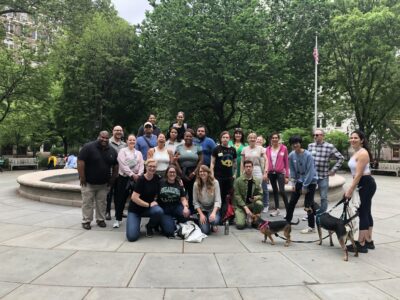
This story is part of Grow PA, a reported series on economic development across 10 Pennsylvania counties supported by the Chamber of Commerce for Greater Philadelphia. Sign up for our weekly curated email here.
About ten miles outside the Pa. state capitol sits Middletown, a small town of about 9,000 Pennsylvanians perhaps best known for the Penn State Harrisburg campus that drives its local economy.
Middletown is neutral territory, sitting outside the capital of a state often polarized by the two major metropolises that anchor each of its southern corners. But last week, the town hosted over 125 civic and business leaders from across the state, all of whom were convened to vote on policy ideas that will ultimately be used to build an economic growth agenda for the 2018 gubernatorial election and beyond.
The convening was the first real step forward for Grow PA, an initiative spearheaded by the Chamber of Commerce for Greater Philadelphia that aims to create a shared plan by engaging economic development leaders on policies that will move local economies forward — policies that specifically impact healthcare, post-secondary education and infrastructure, the three sectors best-positioned to create economic prosperity for Pennsylvanians.
(Technical.ly has spent the past six months supporting Grow PA with an eponymous underwritten reporting series that has been highlighting successes and trends in select counties across the Commonwealth.)
Grow PA, according to Chamber President and CEO Rob Wonderling, is an “open-source initiative” that stakeholders hope will engage 2,000 Pennsylvanians. In a state with an unemployment rate that lags behind the national average and an aging population that’s on the decline for the first time in 31 years, the time to collectively plan a path forward is now.
“We’re counting on you to build the agenda,” said Wonderling. “We’re counting on not just all of you here today, but folks who are in your networks and at your organizations, to build a economic growth agenda over the next several months.”
It’s not the first time Middletown has been the nucleus of a statewide plan for economic growth. In the early 19th century, state legislators had a vision for the town as the primary artery for commerce in the Commonwealth.
That vision was made manifest in 1826, when then-Governor John Andrew Schulze authorized The Main Line Public Works, a legislative package that permitted the construction of canals, roads and rail systems spanning the state. For about three decades – until it was purchased by the Pennsylvania Railroad Company – the Main Line Public Works created economic prosperity for Pennsylvanians from Pittsburgh to Harrisburg to Philadelphia.
Almost two centuries later, infrastructure investment and development remains a major priority for Pennsylvania.
Infrastructure
“Roads and bridges, airports, water treatment, telecommunications, fiber optics, pipelines — all these assets dramatically affect the quality of life for everyone across the state,” said Michael Della Rocca, Infrastructure Partner at McKinsey & Company. “They are unquestionably linked to economic growth and prosperity.”
Nobody thinks about infrastructure until it doesn’t work, said Della Rocca. And, considering high cost, potential environmental consequences and the time it takes to properly plan development, investment in infrastructure can be a hard case to make in times of economic stress.
Here’s how attendees prioritized policies impacting infrastructure:

Infrastructure voting results. (Photo courtesy of the Chamber of Commerce for Greater Philadelphia.)
“I would say I agree with all of the above [priorities, but] I think some of these things can be done with private capital and save taxpayer dollars,” said Christopher Franklin, President and CEO of Aqua.
Disparity, however, revealed itself when discussing internet access. Representatives from rural Pa. were surprised to find the room so split on high speed internet.
“I think it might have something to do with where we are geographically,” said one attendee, referring to the expansive broadband networks that support local economies in Southeastern and Southwestern Pa.
“I live way in the country, and the only thing we have available is satellite internet,” another attendee added. “It’s limited by the number of gigabytes you’re allowed per month. You really have to think about how much internet you use.”
Post-Secondary Education
From top-tier universities to deeply-rooted community colleges, Pennsylvania has no shortage of educational institutions. It is, however, hemorrhaging talent, and employers are struggling to create enough jobs to keep graduates around.
Brain drain, according to PSU President Eric J. Barron, is a major ailment in need of a remedy.
“Over and over again, [graduates] leave Pennsylvania,” he said. “Even though they’re ready and eager, they don’t necessarily see that we’re a land of opportunity.”
According to Barron, PSU’s investment fund has helped launch 48 startups this year, and the university now offers student entrepreneurs free legal advice.
“From my viewpoint, we lack the resources to be innovators in a lot of different ways. Companies want to be associated with the people who will set the stage for the future and disrupt some technology,” said Barron. “Infrastructure is very important to me, but having the opportunity to have innovators … that’s what the real attractor is.”
Here’s how attendees voted on post-secondary education priorities:

Voting results on higher education. (Photo courtesy of the Chamber of Commerce for Greater Philadelphia)
Pennsylvania, many in the room agreed, needs more workers with two-year degrees. The challenge is not so much aligning education programs with the needs of employers as it is finding the funding to support that talent pipeline.
While labor force growth is challenged and impacted by an aging population, said FS Investments Senior Economist Lara Rhame, Pennsylvania has a well-educated labor force with productivity output on par with the rest of the country.
“What we need to pivot to is [the] concern that people are being employed by their fullest potential,” Rhame said. “People can find a job, they just might not be finding a full time job. That mismatch is something we’re seeing somewhat in the data.”
(One attendee pointed out a common mistake when discussing the GED: “Stop saying GED is the credential. The GED is only the test mechanism. When [students] pass a GED, they do not get a GED, they get a high school diploma.”)
Healthcare
Out of every issue voted on during the convening, allowing for better, more accessible and more affordable healthcare was the priority that garnered the most votes for “high priority.”
Overwhelmingly so. After all, said UnitedHealthcare Community Plan for Pennsylvania CEO Allison Davenport, a healthy workforce is a productive workforce.
“When I think about these priorities, I think about how we would apply them in the context of a specific problem: The opioid epidemic,” the exec advised. “Deaths have increased 36 percent in Pa. in the past five years. I tested out that problem against the priorities, and I think those are the right priorities.”
Here’s how the voting went down:

Voting results for healthcare. (Photo courtesy of the Chamber of Commerce for Greater Philadelphia.)
Why such an outpouring of support for increased access to better and more affordable healthcare?
“It’s the only one that’s personal,” said one attendee. “That one affects each and every person.”
Next Steps
These results, said Wonderling, will provide a foundation for the growth agenda. Grow PA stakeholders hope to begin thinking through some of the specifics over the next few months before convening again on March 6, 2018 to host a gubernatorial primary election debate at the National Constitution Center in Philadelphia.
(Want to engage? Sign up for our weekly curated newsletter here).
“As we think about how to bring business and improve business creation here in Pa., we can’t lose track of the fact that we need to invest in schools, things that make raising and keeping families here [easier],” she said. “There’s real room for keeping families here and developing labor force growth and infrastructure.”
[googlemaps https://www.google.com/maps/d/u/0/embed?mid=1fAjLwwFCWeFH3RWL0dxRnqZF5y4&w=300&h=150]
Join the conversation!
Find news, events, jobs and people who share your interests on Technical.ly's open community Slack

Philly’s IT department fires long-tenured staff amid a high-level shakeup of priorities

Why is it so hard to find entry-level software engineering jobs?

This Week in Jobs: Get out there with 22 new job opportunities available to you!

